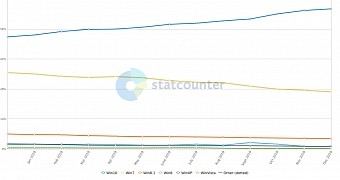We’re only a few days away from the moment Windows 7 is scheduled to receive the last set of security updates, with Microsoft to then retire what has become one of the most successful operating systems it ever released.
There’s no doubt Windows 7 was a hit, and its existing market share is the living confirmation of just how popular the 2009 OS currently is even today after more than 10 years since its launch.
But at the same time, this market share confirms that the world isn’t ready to let Windows 7 go, as way too many users don’t want to upgrade their devices and switch to an OS that continues to receive security patches.
Moving forward, Microsoft will continue to support Windows 8.1 and Windows 10, but the latter is obviously the preferred choice for the Redmond-based software giant. As a matter of fact, Windows 7 users can still upgrade to Windows 10 free of charge – Microsoft originally offered the free upgrades as part of a promo that was available in the first 12 months after the launch of Windows 10.
But right now, anyone running Windows 7 should be able to upgrade to Windows 10 at no cost.
Getting back to the market share of Windows 7, the data provided by StatCounter shows that while Windows 7 declined, Windows 10 improved. This isn’t necessarily surprising, not only given the approaching end of support for Windows 7, but also considering the aggressive upgrade push that Microsoft has embraced.
So in December 2019, Windows 7 was running on 26.79% of the Windows devices out there, while Windows 10 reached a personal best of 65.4%. Certainly, the difference is big enough to clearly show that most Windows 7 users moved to Windows 10, but on the other hand, the graph that you see here confirms that most users don’t see any rush in upgrading their devices before the January 14 deadline.
The decline of Windows 7 has happened gradually with no steep drop experienced from one month to another. And what’s more, it even slowed down lately, which is kind of surprising given that the end of support is just around the corner. In October, Windows 7 was running on 27.98% of the Windows devices, dropping to 27.49% the next month and to 26.79% in December. This means it lost a little over 1% in two months, which for an operating system whose demise is almost happening is something rather unexpected.
Windows 8.1 sees no real benefit from the death of Windows 7, which again confirms that most upgraders choose Windows 10. Windows 8.1 had a market share of 5.07% in October, 4.98% in November, and 4.87% in December.
The death of Windows 7 won’t happen overnight, that’s for sure, albeit I do expect the decline to gain more speed in the coming months after Microsoft delivers the last batch of security patches.
Enterprises are likely to purchase custom support, at least for one year, especially as Windows 7 is broadly used in large fleets. The upgrade to Windows 10 is for many a costly process, especially as buying new hardware is often involved, but sooner or later, everyone will have to do it.
Windows XP is the living proof that the transition from a successful operating system to a newer sibling takes place much slower than anticipated, and it all happens despite the obvious security risks caused by running unsupported software.
Windows 7 will indeed receive the last updates on January 14, but these stats show it’ll stick around for a lot longer. And I bet we won’t see it going away too soon.

 14 DAY TRIAL //
14 DAY TRIAL //